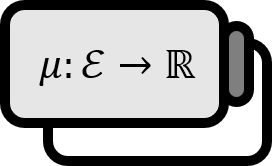Monotone Convergence Theorem Proof
Theorem 1
Let us assume that a sequence $\left\{ f_{n} \right\}$ of measurable functions with non-negative values satisfies $f_{n} \nearrow f$. Then $$ \lim_{n \to \infty} \int_{E} f_{n} dm = \int_{E} f dm $$
Explanation
$f_{n} \nearrow f$ means that for all $x$, if $f_{n}(x) \le f_{n+1} (x)$ while $\displaystyle \lim_{n \to \infty} f_{n} = f$. The formula is too simple, so knowing this theorem means precisely understanding the ‘condition’. In terms of usefulness, it implies that limits can freely cross integrals, which is unequivocally beneficial.
Proof
Since $f_{n} \le f$, $$ \limsup_{n \to \infty} \int_{E} f_{n} dm \le \int_{E} f dm $$
Fatou’s Lemma: For a sequence $\left\{ f_{n} \right\}$ of measurable functions with non-negative values $$\displaystyle \int_{E} \left( \liminf_{n \to \infty} f_{n} \right) dm \le \liminf_{n \to \infty} \int_{E} f_{n} dm $$
By Fatou’s Lemma and the properties of limit infimum, $\displaystyle \int_{E} f dm \le \liminf_{n \to \infty} \int_{E} f_{n} dm$ holds, and summarizing, $$\displaystyle \limsup_{n \to \infty} \int_{E} f_{n} dm \le \int_{E} f dm \le \liminf_{n \to \infty} \int_{E} f_{n} dm $$ However, obviously $\displaystyle \liminf_{n \to \infty} \int_{E} f_{n} dm \le \limsup_{n \to \infty} \int_{E} f_{n} dm$, therefore $$\displaystyle \limsup_{n \to \infty} \int_{E} f_{n} dm = \int_{E} f dm = \liminf_{n \to \infty} \int_{E} f_{n} dm$$ must hold.
■
Corollary
Let us assume that a sequence $\left\{ f_{n} \right\}$ of measurable functions with non-negative values satisfies $f_{n} \nearrow f$ almost everywhere. Then $$\lim_{n \to \infty} \int_{E} f_{n} dm = \int_{E} f dm$$ and, in particular $$ \int \sum_{n=1}^{\infty} f_{n} dm = \sum_{n=1}^{\infty} \int f_{n} dm$$
Capinski. (1999). Measure, Integral and Probability: p84. ↩︎
